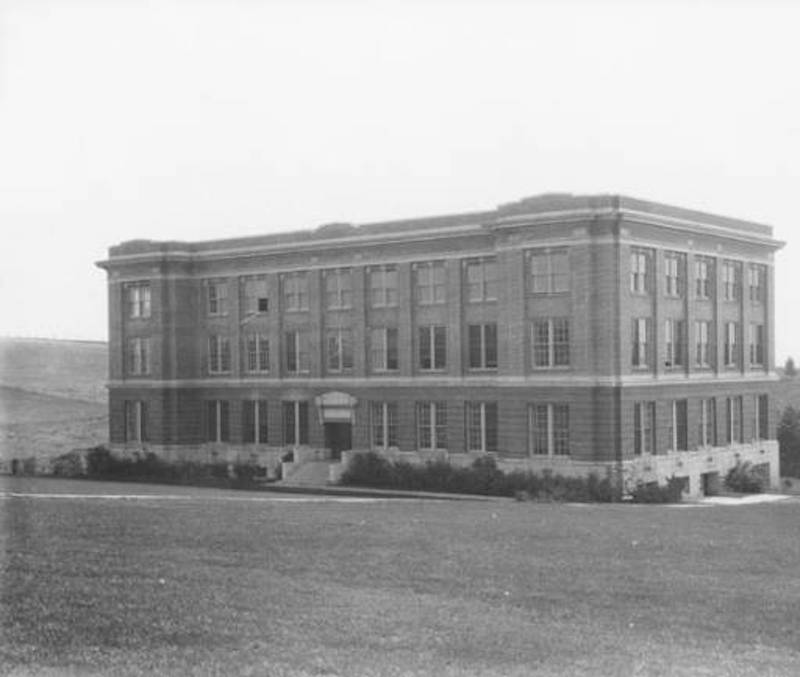When Troy Hall was constructed in 1921, it was used as a dairy building that housed the Washington State University (WSU) Creamery, Ferdinand’s Ice Cream Shoppe, and chemistry classes. After closing its doors in 2010, Troy Hall retired its cheese equipment and decided to focus on the chemistry. Roughly seven years later, Troy Hall reopened as the new home of the Department of Chemistry and School of the Environment.
The Perkins+Will-designed building added almost 15,000 sf of new space to the north of the building, bringing the total square footage of the four-story building up to 50,000. The new space is used for private and open offices and meeting spaces of various sizes.
Photo courtesy Perkins+Will.
An oversized, naturally lit staircase connects the new space with the rest of the 35,000-sf building. Collaborative and informal meeting spaces are located near the new stairwell on each floor. These new spaces are meant to form the new “academic heart” of Troy Hall. Teaching and research labs and flexible spaces that can be used for a variety of uses fill out the rest of the building.
Due to the historic nature of the building, Perkins+Will preserved as much of the historic character as possible. All four walls from the original 1920s façade and the terra cotta from the original entrance were deconstructed, restored, and relocated to the building’s new front door.
Photo courtesy Perkins+Will.
In addition to Perkins+Will, the design-build team also comprised Lydig Construction. The rest of the build team was composed of Parametric, Inc. (CE), Coughlin Porter Lundeen (SE), PAE Engineers (MEP), and Swift Company (landscape architect).
Photo courtesy of Perkins+Will.
Photo courtesy of Perkins+Will.
 Photo: PC 70 Hutchison Studio Photographs of W.S.U.
Photo: PC 70 Hutchison Studio Photographs of W.S.U.
Related Stories
Market Data | Aug 1, 2023
Nonresidential construction spending increases slightly in June
National nonresidential construction spending increased 0.1% in June, according to an Associated Builders and Contractors analysis of data published today by the U.S. Census Bureau. Spending is up 18% over the past 12 months. On a seasonally adjusted annualized basis, nonresidential spending totaled $1.07 trillion in June.
Market Data | Jul 24, 2023
Leading economists call for 2% increase in building construction spending in 2024
Following a 19.7% surge in spending for commercial, institutional, and industrial buildings in 2023, leading construction industry economists expect spending growth to come back to earth in 2024, according to the July 2023 AIA Consensus Construction Forecast Panel.
Mass Timber | Jul 11, 2023
5 solutions to acoustic issues in mass timber buildings
For all its advantages, mass timber also has a less-heralded quality: its acoustic challenges. Exposed wood ceilings and floors have led to issues with excessive noise. Mass timber experts offer practical solutions to the top five acoustic issues in mass timber buildings.
Adaptive Reuse | Jul 6, 2023
The responsibility of adapting historic university buildings
Shepley Bulfinch's David Whitehill, AIA, believes the adaptive reuse of historic university buildings is not a matter of sentimentality but of practicality, progress, and preservation.
University Buildings | Jun 26, 2023
Univ. of Calif. Riverside’s plant research facility enables year-round plant growth
The University of California, Riverside’s new plant research facility, a state-of-the-art greenhouse with best-in-class research and climate control technologies, recently held its grand opening. Construction of the two-story, 30,000 sf facility was completed in 2021. It then went through two years of preparation and testing.
University Buildings | Jun 26, 2023
Addition by subtraction: The value of open space on higher education campuses
Creating a meaningful academic and student life experience on university and college campuses does not always mean adding a new building. A new or resurrected campus quad, recreational fields, gardens, and other greenspaces can tie a campus together, writes Sean Rosebrugh, AIA, LEED AP, HMC Architects' Higher Education Practice Leader.
Standards | Jun 26, 2023
New Wi-Fi standard boosts indoor navigation, tracking accuracy in buildings
The recently released Wi-Fi standard, IEEE 802.11az enables more refined and accurate indoor location capabilities. As technology manufacturers incorporate the new standard in various devices, it will enable buildings, including malls, arenas, and stadiums, to provide new wayfinding and tracking features.
Laboratories | Jun 23, 2023
A New Jersey development represents the state’s largest-ever investment in life sciences and medical education
In New Brunswick, N.J., a life sciences development that’s now underway aims to bring together academics and researchers to work, learn, and experiment under one roof. HELIX Health + Life Science Exchange is an innovation district under development on a four-acre downtown site. At $731 million, HELIX, which will be built in three phases, represents New Jersey’s largest-ever investment in life sciences and medical education, according to a press statement.
Engineers | Jun 14, 2023
The high cost of low maintenance
Walter P Moore’s Javier Balma, PhD, PE, SE, and Webb Wright, PE, identify the primary causes of engineering failures, define proactive versus reactive maintenance, recognize the reasons for deferred maintenance, and identify the financial and safety risks related to deferred maintenance.
University Buildings | Jun 14, 2023
Calif. State University’s new ‘library-plus’ building bridges upper and lower campuses
A three-story “library-plus” building at California State University, East Bay (CSUEB) that ties together the upper and lower campuses was recently completed. The 100,977-sf facility, known as the Collaborative Opportunities for Research & Engagement (“CORE”) Building, is one of the busiest libraries in the CSU system. The previous library served 1.2 million visitors annually.
















